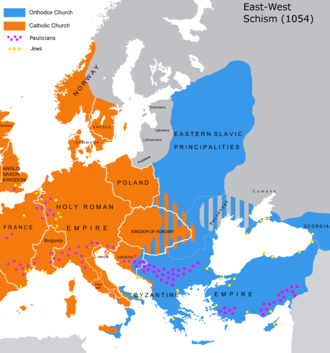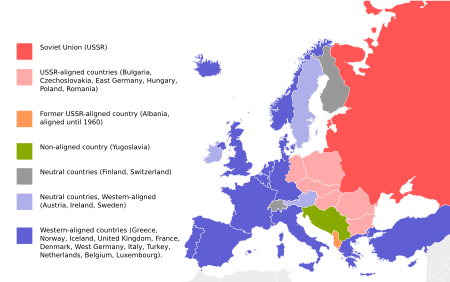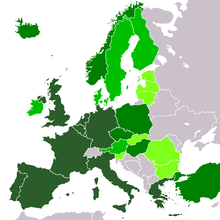Western Europe
Western Europe is the region comprising the western part of Europe. Though the term Western Europe is commonly used, there is no consensus on which countries comprise it.
Significant historical events that have shaped the concept of Western Europe include the rise of Rome, the influence of Greek culture on the Roman Republic, the adoption of Christianity by Roman Emperors, the division of the Latin West and Greek East, the Fall of the Western Roman Empire, the reign of Charlemagne, the Viking invasions, the East–West Schism, the Black Death, the Renaissance, the Age of Discovery, the Protestant Reformation as well as the Counter-Reformation of the Catholic Church, the Age of Enlightenment, the French Revolution, the Industrial Revolution, the two world wars, the Cold War, the formation of the North Atlantic Treaty Organization and the expansion of the European Union.
Historical divisions
Classical antiquity and medieval origins

Prior to the Roman conquest, a large part of Western Europe had adopted the newly developed La Tène culture. As the Roman domain expanded, a cultural and linguistic division appeared between the mainly Greek-speaking eastern provinces, which had formed the highly urbanized Hellenistic civilization, and the western territories, which in contrast largely adopted the Latin language. This cultural and linguistic division was eventually reinforced by the later political east–west division of the Roman Empire. The Western Roman Empire and the Eastern Roman Empire controlled the two divergent regions between the 3rd and the 5th centuries.
The division between these two was enhanced during Late antiquity and the Middle Ages by a number of events. The Western Roman Empire collapsed, starting the Early Middle Ages. By contrast, the Eastern Roman Empire, mostly known as the Greek or Byzantine Empire, survived and even thrived for another 1000 years. The rise of the Carolingian Empire in the west, and in particular the Great Schism between Eastern Orthodoxy and Roman Catholicism, enhanced the cultural and religious distinctiveness between Eastern and Western Europe.
After the conquest of the Byzantine Empire, center of the Eastern Orthodox Church, by the Muslim Ottoman Empire in the 15th century, and the gradual fragmentation of the Holy Roman Empire (which had replaced the Carolingian Empire), the division between Roman Catholic and Protestant became more important in Europe than that with Eastern Orthodoxy.
In East Asia, Western Europe was historically known as taixi in China and taisei in Japan, which literally translates as the "Far West". The term Far West became synonymous with Western Europe in China during the Ming dynasty. The Italian Jesuit priest Matteo Ricci was one of the first writers in China to use the Far West as an Asian counterpart to the European concept of the Far East. In Ricci's writings, Ricci referred to himself as "Matteo of the Far West".[3] The term was still in use in the late 19th and early 20th centuries.
Religion

Christianity is the largest religion in Western Europe, according to a 2018 study by the Pew Research Center, 71.0% of the Western European population identified themselves as Christians.[5]
The East–West Schism, which has lasted since the 11th century, divided Christianity in Europe, and consequently the world, into Western Christianity and Eastern Christianity.
With certain simplifications, Western Europe is thus Catholic or Protestant and uses the Latin alphabet. Eastern Europe is Orthodox and uses the Greek alphabet or Cyrillic script.
According to this definition, Western Europe is formed by countries with dominant Roman Catholic and Protestant churches, including countries which are considered part of Central Europe now: Austria, Belgium, Croatia, Czech Republic, Denmark, Estonia, Finland, France, Germany, Hungary, Iceland, Ireland, Italy, Latvia, Liechtenstein, Lithuania, Luxembourg, Malta, Netherlands, Norway, Poland, Portugal, Slovakia, Slovenia, Spain, Sweden, Switzerland and United Kingdom.
Eastern Europe, meanwhile is formed by countries with dominant Eastern Orthodox churches, including Greece, Belarus, Bulgaria, Serbia, Romania, Russia, and Ukraine for instance.
The schism is the break of communion and theology between what are now the Eastern (Orthodox) and Western (Roman Catholic from the 11th century, as well as from the 16th-century, also Protestant) churches.
This division dominated Europe for centuries, in opposition to the rather short-lived Cold War division of four decades.
Since the Great Schism of 1054, Europe has been divided between Roman Catholic and Protestant churches in the West and the Eastern Orthodox Christian (many times incorrectly labeled "Greek Orthodox") churches in the east. Due to this religious cleavage, Eastern Orthodox countries are often associated with Eastern Europe. A cleavage of this sort is, however, often problematic; for example, Greece is overwhelmingly Orthodox, but is very rarely included in "Eastern Europe", for a variety of reasons.[6]
Cold War

During the four decades of the Cold War, the definition of East and West was rather simplified by the existence of the Eastern Bloc. Historians and social scientists generally view the Cold War definition of Western and Eastern Europe as outdated or relegating.[7][8][9][10]
During the final stages of World War II, the future of Europe was decided between the Allies in the 1945 Yalta Conference, between the British Prime Minister, Winston Churchill, the U.S. President, Franklin D. Roosevelt, and the Premier of the Soviet Union, Joseph Stalin.
Post-war Europe would be divided into two major spheres: the Western Bloc, influenced by the United States, and the Eastern Bloc, influenced by the Soviet Union. With the onset of the Cold War, Europe was divided by the Iron Curtain. This term had been used during World War II by German Propaganda Minister Joseph Goebbels and, later, Count Lutz Schwerin von Krosigk in the last days of the war; however, its use was hugely popularized by Winston Churchill, who used it in his famous "Sinews of Peace" address on 5 March 1946 at Westminster College in Fulton, Missouri:
From Stettin in the Baltic to Trieste in the Adriatic an iron curtain has descended across the Continent. Behind that line lie all the capitals of the ancient states of Central and Eastern Europe. Warsaw, Berlin, Prague, Vienna, Budapest, Belgrade, Bucharest and Sofia; all these famous cities and the populations around them lie in what I must call the Soviet sphere, and all are subject, in one form or another, not only to Soviet influence but to a very high and in some cases increasing measure of control from Moscow.
Although some countries were officially neutral, they were classified according to the nature of their political and economic systems. This division largely defines the popular perception and understanding of Western Europe and its borders with Eastern Europe.

The world changed dramatically with the fall of the Iron Curtain in 1989. West Germany peacefully absorbed East Germany, in the German reunification. Comecon and the Warsaw Pact were dissolved, and in 1991, the Soviet Union ceased to exist. Several countries which had been part of the Soviet Union regained full independence.
Western European Union
In 1948 the Treaty of Brussels was signed between Belgium, France, Luxembourg, the Netherlands and the United Kingdom. It was further revisited in 1954 at the Paris Conference, when the Western European Union was established. It was declared defunct in 2011 after the Treaty of Lisbon, and the Treaty of Brussels was terminated. When the Western European Union was dissolved, it had 10 member countries, six associate member countries, five observer countries and seven associate partner countries.
Modern divisions
Geography: Realms, Regions, and Concepts
Geography: Realms, Regions, and Concepts has been published since 1971 and now in its 17th edition.[11] It was written by the authors Jan Nijman, Peter O. Muller and Harm J. de Blij. It is used in many US schools to teach students world geography.
Here, the definition of Western Europe includes:[11]
CIA classification

The CIA classifies seven countries as belonging to "Western Europe":[12]
The CIA also classifies three countries as belonging to "Southwestern Europe":
Western European and Others Group
The Western European and Others Group is one of several unofficial Regional Groups in the United Nations that act as voting blocs and negotiation forums. Regional voting blocs were formed in 1961 to encourage voting to various UN bodies from different regional groups. The European members of the group are:[13]
In addition, Australia, Canada, Israel and New Zealand are members of the group, with the United States as observer.
Population
Using the CIA classification strictly would give the following calculation of Western Europe's population. All figures based on the projections for 2018 by the Population Division of the United Nations Department of Economic and Social Affairs.[14]
| Rank | Country or territory | Population (most recent estimates) | Languages | Capital |
|---|---|---|---|---|
| 1 | United Kingdom | 66,040,229 | English | London |
| 2 | France (metropolitan) | 65,058,000 | French | Paris |
| 3 | Netherlands | 17,249,632 | Dutch, Frisian | Amsterdam |
| 4 | Belgium | 11,420,163 | Dutch, French and German | Brussels |
| 5 | Ireland | 4,857,000 | Irish, English | Dublin |
| 6 | Luxembourg | 602,005 | French, Luxembourgish and German | Luxembourg City |
| 7 | Monaco | 38,300 | French | Monaco (city-state) |
| Total | 165,265,329 |
Using the CIA classification a little more liberally and including "South-Western Europe", would give the following calculation of Western Europe's population.[14]
| Rank | Country or territory | Population (most recent estimates) | Languages | Capital |
|---|---|---|---|---|
| 1 | United Kingdom | 66,040,229 | English | London |
| 2 | France (metropolitan) | 65,058,000 | French | Paris |
| 3 | Spain | 46,700,000 | Spanish | Madrid |
| 4 | Netherlands | 17,249,632 | Dutch, Frisian | Amsterdam |
| 5 | Belgium | 11,420,163 | Dutch, French | Brussels |
| 6 | Portugal | 10,291,027 | Portuguese | Lisbon |
| 7 | Ireland | 4,857,000 | Irish, English | Dublin |
| 8 | Luxembourg | 602,005 | French, Luxembourgish and German | Luxembourg City |
| 9 | Andorra | 78,264 | Catalan | Andorra la Vella |
| 10 | Monaco | 38,300 | French | Monaco (city-state) |
| Total | 222,293,922 |
Climate
The climate of Western Europe varies from subtropical and semi-arid in the coasts of Italy, Portugal and Spain to alpine in the Pyrenees and the Alps. The Mediterranean climate of the south is dry and warm. The western and northwestern parts have a mild, generally humid climate, influenced by the North Atlantic Current.
Languages
Western European languages mostly fall within two Indo-European language families: the Romance languages, descended from the Latin of the Roman Empire; and the Germanic languages, whose ancestor language (Proto-Germanic) came from southern Scandinavia.[15] Romance languages are spoken primarily in the southern and central part of Western Europe, Germanic languages in the northern part (the British Isles and the Low Countries), as well as a large part of Northern and Central Europe.[15]
Other Western European languages include the Celtic group (that is, Irish, Scottish Gaelic, Manx, Welsh, Cornish and Breton[15]) and Basque, the only currently living European language isolate.[16]
Multilingualism and the protection of regional and minority languages are recognized political goals in Western Europe today. The Council of Europe Framework Convention for the Protection of National Minorities and the Council of Europe's European Charter for Regional or Minority Languages set up a legal framework for language rights in Europe.
Economy
Western Europe is one of the richest regions of the world. Germany has the highest GDP in Europe and the largest financial surplus of any country, Luxembourg has the world's highest GDP per capita, and Germany has the highest net national wealth of any European state.
Switzerland and Luxembourg have the highest average wage in the world, in nominal and PPP, respectively. Norway ranks highest in the world on the Social Progress Index.
See also
References
Citations
- "Atlas of the Historical Geography of the Holy Land". Rbedrosian.com. Archived from the original on 10 June 2013. Retrieved 23 February 2013.
- "home.comcast.net". Archived from the original on 13 February 2013. Retrieved 23 February 2013.
- Ricci, Matteo (1610) [2009]. On Friendship: One Hundred Maxims for a Chinese Prince. Translated by Timothy Billings. Columbia University Press. pp. 19, 71, 87. ISBN 978-0231149242.
- Dragan Brujić (2005). "Vodič kroz svet Vizantije (Guide to the Byzantine World)". Beograd. p. 51.
- "Being Christian in Western Europe", Pew Research Center, Pew Research Center, 2018, retrieved 29 May 2018
- Peter John, Local Governance in Western Europe, University of Manchester, 2001, ISBN 9780761956372
- "The geopolitical conditions (...) are now a thing of the past, and some specialists today think that Eastern Europe has outlived its usefulness as a phrase.""Regions, Regionalism, Eastern Europe by Steven Cassedy". New Dictionary of the History of Ideas, Charles Scribner's Sons. 2005. Retrieved 31 January 2010. Cite journal requires
|journal=(help) - "One very common, but now outdated, definition of Eastern Europe was the Soviet-dominated communist countries of Europe."http://www.cotf.edu/earthinfo/balkans/BKdef.html Archived 10 December 2017 at the Wayback Machine
- "Too much writing on the region has – consciously or unconsciously – clung to an outdated image of 'Eastern Europe', desperately trying to patch together political and social developments from Budapest to Bukhara or Tallinn to Tashkent without acknowledging that this Cold War frame of reference is coming apart at the seams. Central Europe Review: Re-Viewing Central Europe By Sean Hanley, Kazi Stastna and Andrew Stroehlein, 1999 Archived 31 October 2017 at the Wayback Machine
- Berglund, Sten; Ekman, Joakim; Aarebrot, Frank H. (2004). The handbook of political change in Eastern Europe. p. 2. ISBN 9781781954324. Retrieved 5 October 2011.
The term 'Eastern Europe' is ambiguous and in many ways outdated.
- "Confirmed: Czech Republic is in Western Europe, says US textbook". News.expats.cz.
- "Field listing: Location". CIA World Factbook. Archived from the original on 24 May 2011. Retrieved 30 July 2017.
- UNAIDS, The Governance Handbook, January 2010 Archived 9 January 2011 at the Wayback Machine (p. 29).
- "World Population Prospects 2018". Archived from the original on 19 September 2016. Retrieved 14 October 2018.
- "Europe". Encyclopædia Britannica. 2007. Retrieved 10 June 2008.
- "Basque language". Encyclopedia Britannica. Retrieved 16 June 2020.
Sources
- The Making of Europe, ISBN 0-14-015409-4, by Robert Bartlett
- Crescent and Cross, ISBN 1-84212-753-5, by Hugh Bicheno
- The Normans, ISBN 0-7524-2881-0, by Trevor Rowley
- 1066: The Year of the Three Battles, ISBN 0-7126-6672-9, by Frank McLynn
External links
| Wikimedia Commons has media related to: |